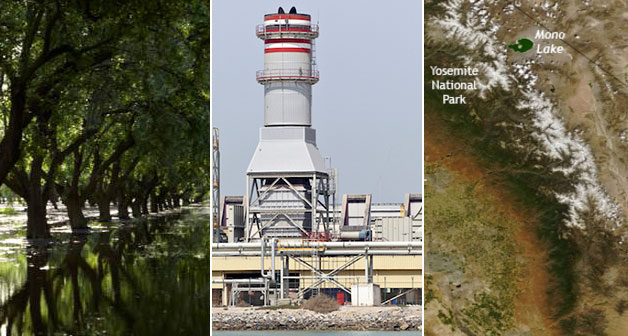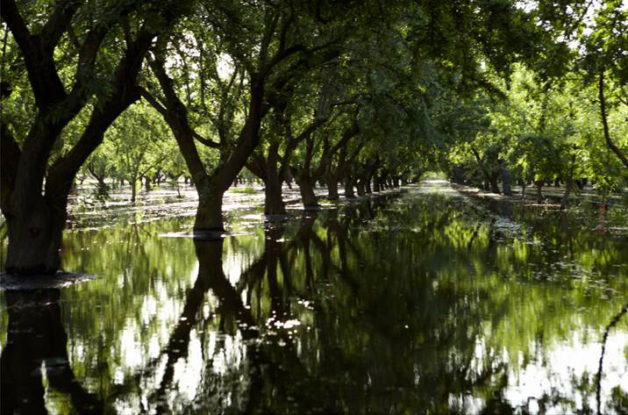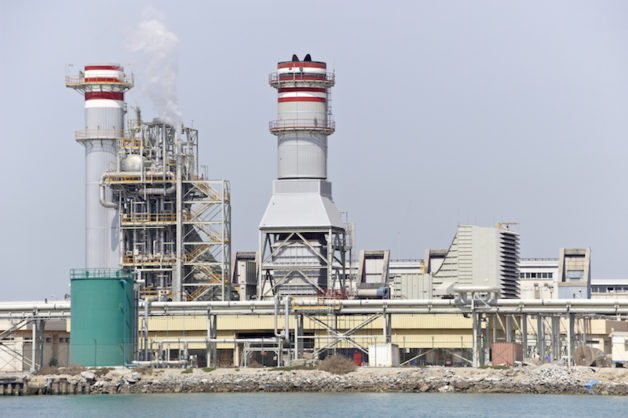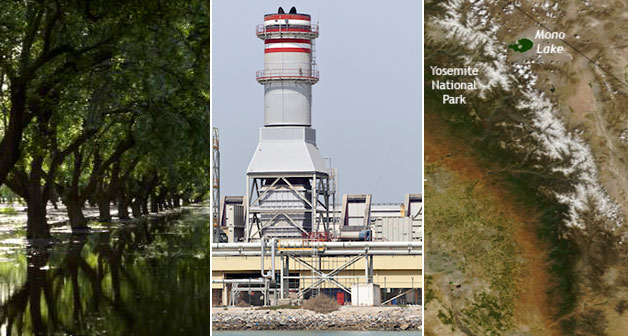
Water banking, desalination, and high-resolution climate models are all part of the new Berkeley Lab Water Resilience Initiative. (California snowpack photo credit: Dan Pisut/ NASA)
Billions of gallons of water are used each day in the United States for energy production—for hydroelectric power generation, thermoelectric plant cooling, and countless other industrial processes, including oil and gas mining. And huge amounts of energy are required to pump, treat, heat, and deliver water.
This interdependence of water and energy is the focus of a major new research effort at the Department of Energy’s Lawrence Berkeley National Laboratory (Berkeley Lab). With the twin challenges of population growth and climate change adding to the resource pressures, Berkeley Lab’s Water Resilience Initiative aims to use science and technology to optimize coupled water-energy systems and guide investments in such systems.
“Considering water and energy as separate issues is passé,” said Berkeley Lab scientist Robert Kostecki, one of the three leads of the initiative. “Now the two are becoming critically interdependent. And both the energy and water sectors are expected to experience serious stresses from extreme climate events. However the problem on each side is dealt with, there needs to be an understanding of possible implications on the other side.”
The Initiative has three main goals: hydroclimate and ecosystem predictions, revolutionary concepts for efficient and sustainable groundwater systems, and science and technology breakthroughs in desalination. The goals can be viewed as analogous to energy distribution, storage, and generation, says Susan Hubbard, Berkeley Lab’s Associate Lab Director for Earth and Environmental Sciences.
“We consider improved hydroclimate predictions as necessary for understanding future water distribution,” Hubbard said. “We are exploring water banking as a subsurface strategy to store water that is delivered by snowmelt or extreme precipitation. To remain water resilient in other locations and to take advantage of seawater through brackish inland produced waters, Berkeley Lab is performing fundamental investigations to explore new approaches to desalinate water, ideally leading to cost and energy efficient approaches to generate water.”
Climate: the Source of All Water
The climate, ultimately, is the source of all water, and in places like California, where the snow pack plays an important role, climate change will have a big impact on how much water there will be and when it will come. The goal of the climate focus of the Initiative, led by Berkeley Lab climate scientist Andrew Jones, is to develop approaches to predict hydroclimate at scales that can be used to guide water-energy strategies.
“Historically we’ve developed climate models that are global models, developed to answer global science questions,” Jones said. “But there’s an increasing demand for information at much finer spatial scales to support climate adaptation planning.”
Ten years ago, Berkeley Lab scientists helped develop global climate models with a resolution of 200 kilometers. By 2012, the most advanced models had 25 km resolution. Now a project is underway to develop a regional climate model of the San Francisco Bay Area with resolution of 1 km, or the neighborhood level.
“We’ll be looking at the risk of extreme heat events and how that interacts with the microclimates of the Bay Area, and additionally, how change in the urban built environment can exacerbate or ameliorate those heat events,” Jones said. “Then we want to understand the implications of those heat events for water and energy demands.”
The eventual goal is to transfer this model for use in other urban areas to be able to predict extreme precipitation events as well as drought and flood risk.
Subsurface: Storage, Quality, and Movement of Water Underground
Another Initiative focus, led by Peter Nico, head of Berkeley Lab’s Geochemistry Department, studies what’s happening underground. “We have a lot of expertise in understanding the subsurface—using various geophysical imaging techniques, measuring chemical changes, using different types of hydrologic and reactive transport models to simulate what’s happening,” he said. “So our expertise matches up very well with groundwater movement and management and groundwater quality.”
Groundwater issues have become more important with the drought of the last four years. “California has been ‘overdrafting’ water for a long time, especially in the San Joaquin Valley, where we’re pulling more water out than is naturally infiltrating back in,” Nico said. “With the drought the use of groundwater has gone up even more. That’s causing a lot of problems, like land subsidence.”
While there is already a lot of activity associated with groundwater management in California, Nico added, “we still can’t confidently store and retrieve clean water in the subsurface when and where we need it. We think there’s a place to contribute a more scientific chemistry- and physics-based understanding to efficient groundwater storage in California.”
For example, Berkeley Lab scientists have expertise in using geophysical imaging, which allows them to “see” underground without drilling a well. “We have very sophisticated hydrologic and geochemical computer codes we think we can couple with imaging to predict where water will go and how its chemistry may change through storage or retrieval,” he said.

Berkeley Lab researchers are helping test “water banking” on almond orchards. (Courtesy of Almond Board of California)
They have a new project with the Almond Board of California to determine the ability to recharge over-drafted groundwater aquifers in the San Joaquin Valley by applying peak flood flows to active orchards, known as “water banking.” The project is part of the Almond Board’s larger Accelerated Innovation Management (AIM) program, which includes an emphasis on creating sustainable water resources. Berkeley Lab scientists will work with existing partners, Sustainable Conservation and UC Davis, who are currently conducting field trials and experiments, and contribute their expertise on the deeper subsurface, below the root zone of the almond trees, to determine what happens to banked water as it moves through the subsurface.
Another project, led by Berkeley Lab researcher Larry Dale, is developing a model of the energy use and cost of groundwater pumping statewide in order to improve the reliability of California’s electric and water systems, especially in cases of drought and increase in electricity demand. The project has been awarded a $625,000 grant by the California Energy Commission.
Desalination: Aiming for Pipe Parity
Reverse osmosis is the state-of-the-art desalination technology and has been around since the 1950s. Unfortunately, there have been few breakthroughs in the field of desalination since then, and it remains prohibitively expensive. “The challenge is to lower the cost of desalination of sea water by a factor of five to achieve ‘pipe parity,’ or cost parity with water from natural sources,” said Kostecki, who is leading the project. “This is a formidable endeavor and it cannot be done with incremental improvements of existing technologies.”

Berkeley Lab scientists are working to dramatically lower the cost of desalination. (Credit: Tanuki Photography/istock.com)
To reach this goal, Kostecki and other Berkeley Lab researchers are working on several different approaches for more efficient desalination. Some are new twists on existing technologies—such as forward osmosis using heat from geothermal sources, graphene-based membranes, and capacitive deionization—while others are forging entirely new paradigms, such as using the quantum effects in nanoconfined spaces and new nano-engineered materials architectures.
“The reality is that if one is shooting for a 5X reduction in the cost of desalination of water, then this requires a completely new way of thinking, new science, new technology—this is what we are shooting for,” said Ramamoorthy Ramesh, Associate Lab Director for Energy Technologies.
Some of these projects are part of the U.S./China Clean Energy Research Center for Water Energy Technologies (CERC-WET), a new $64-million collaboration between China and the United States to tackle water conservation in energy production and use. It is a cross-California collaboration led on the U.S. side by Berkeley Lab researcher Ashok Gadgil and funded primarily by the Department of Energy.
“Berkeley Lab is ideally suited to take on the water-energy challenge,” said Ramesh. “As a multidisciplinary lab with deep expertise in energy technologies, computational sciences, energy sciences as well as earth and climate sciences, we have the opportunity to develop and integrate fundamental insights through systems-level approaches. Relevant to California, we are focusing on developing scalable water systems that are resilient in an energy-constrained and uncertain water future.”
# # #
Lawrence Berkeley National Laboratory addresses the world’s most urgent scientific challenges by advancing sustainable energy, protecting human health, creating new materials, and revealing the origin and fate of the universe. Founded in 1931, Berkeley Lab’s scientific expertise has been recognized with 13 Nobel prizes. The University of California manages Berkeley Lab for the U.S. Department of Energy’s Office of Science. For more, visit www.lbl.gov.
DOE’s Office of Science is the single largest supporter of basic research in the physical sciences in the United States, and is working to address some of the most pressing challenges of our time. For more information, please visit science.energy.gov.
